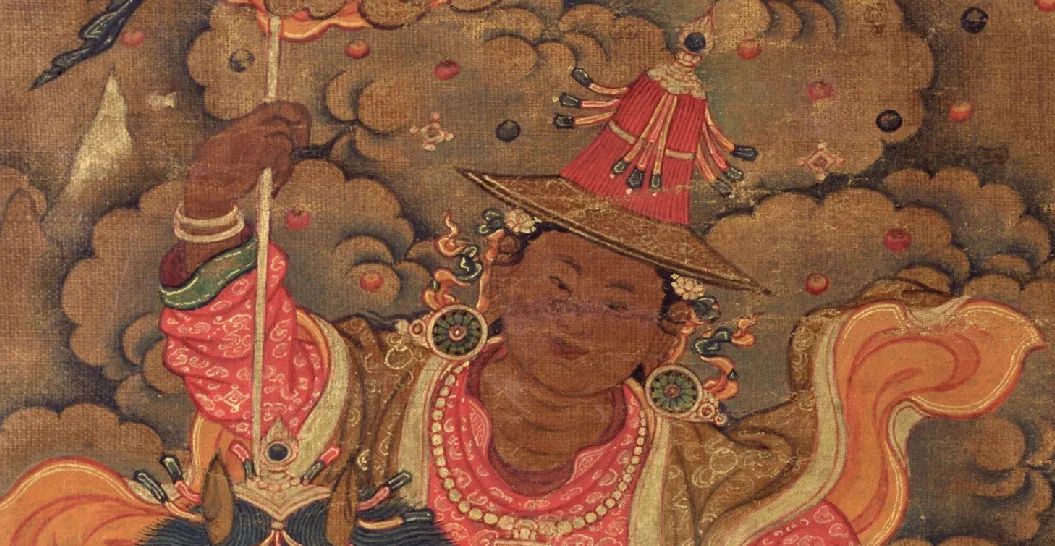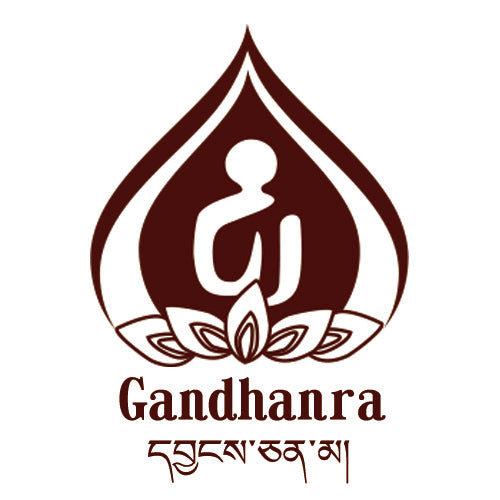
Sacred Mountains and Holy Lakes in Tibet (Part 3) : Surrounded by flying birds and attendants

1940-1941, photographed by H. Staunton (controversial)
Utilizing the overlap of sacred relics and making alterations to pilgrimage routes
Buddhists have reshaped the landscapes of Tibet to align with the narratives of South Asia
The alterations to existing texts are a deliberate intervention
And an attempt to subjugate the mountains and lakes to the sacred traditions of the sages

"The Twelve Danma Goddesses", mid to late 18th century, collected by the Rossi family
The most important goddess combination in the indigenous mountain and lake faith
They occupy a central position in the power structure of Tibet
(Continuously promoted by the Fifth Dalai Lama and various political dynasties)
ང་ནི་པད་མ་འབྱུང་གནས་ཡིན།
In the white Moira temple of the hidden heap
Resides the vow-keeping assembly of dakinis
A multitude of black-skinned wrathful females, a multitude of red-skinned yaksas
A multitude of white-skinned beautiful goddesses, a multitude of sky-blue entities
The twelve supreme Dakinis, the fundamental deity of the Tibetan domain
Excerpt from "The Practice Cycle of the Twelve Dharmapala Goddesses"
(by the first seat holder of Minzhu Monastery, Dechen Rinpoche; 1646-1714)
*Place names marked with an asterisk / Dharmapala can be translated as "guardian deity" /
Mahamo can be translated as "demon mother"
ཀྱེ་རིག་འཛིན་ཆེན་པོ་པད་འབྱུང་གིས།
གཉན་ཆེན་སེ་ཀུ་ག་རུ་ཊ།
Ah ~ the entrusted protector of sentient beings by the great enlightened one, Lotus-born Master
With wings like a thousand precious swords
And tail feathers like a thousand water knives
This divine thought of the great Peng bird
From "Great Reading God Sigu Roc Bird Smoke Explanation"
(གཉན་ཆེན་པོ་སེ་ཀུ་བྱ་ཁྱུང་ལ་བསང་མཆོད་འབུལ་ཚུལ་)
The second Rongbo yogi Ngawang Chile Gyatso
(ངག་དབང་འཕྲིན་ལས་རྒྱ་མཚོ་; 1678-1739)
ག་རུ་ཊ་ is the Sanskrit word for "ड"

"The Mountain God Susgu and its Retinue of Great Peng Birds"
From the collection of the Rubin Museum, 18th century, mid to late period

Local: The face of the Skug Great Peng Bird Mountain God
Personified image wears the traditional hat of the Ando region and is one of the core attendants of the ancient Tibetan god, Animaqing Mountain God.
It has a special belief system and ritual system in the region of Regong.
When the "stranger from a distant land," known to us today as Padmasambhava, arrived in Tibet, he subdued and enlightened the long-revered mountain and lake deities (or the entire indigenous deity system of Tibet). What is accurately portrayed in this text is the fervent anticipation and response strategy of early Buddhist practitioners, that beyond the spiritual world of the native culture, there exists a more powerful divine disciplinary system, where those deities once imbued with ethnic and historical imprints are completely transformed into protectors and proponents of the Buddhist world.
The gods have been admitting through the mouth of a third party in the so-called ritual texts their inherent inferior nature (as spiritual beings of nature) and their lower level of intelligence. This description is almost equivalent to the narratives of the Tubo period of the Tang dynasty in the Buddhist texts, where rulers and subjects are depicted. With the spread of the Lotus Born's teachings throughout Tibet, the "reform movement" targeting the mountain and lake spirits of Tibet has officially begun.
First is the spatial substitution of the description of mountains and lakes, attributing the uniqueness of mountains and lakes to a certain South Asian plot. We can even see the South Asian view of mountains and lakes in the descriptions of mountains and lakes by Tibetan Buddhist philosophers, where ancient gods with superpowers are controlled by sages or deities. For example, the achievements of Milarepa (1040-1123) in the Year of the Horse in the cycle of Mount Kailash, the achievements of the Tertön Zhabje (1161-1211) in the Year of the Monkey in the cycle of sacred mountains, and the Third Gyalwa Karmapa Rangjung Dorje (1284-1339) in the Year of the Sheep in the cycle of Mount Kawa Karpo (the main peak of the Meili Snow Mountain landscape).
"How to initiate the Buddhist lifecycle in the mountain and lake" is gradually clarified with the modifications to the origin myths of the mountain and lake and the intervention of the philosopher's life history (a process filled with the appropriation and recreation of the lotus birth plot). For the remaining Bon tradition (especially the new Bon community), emphasizing the "imperial metaphor" behind its sacred mountains and lakes (such as the famous Bonpo Sacred Mountain and Gyawu Sacred Mountain) becomes extremely important, as it involves specific historical markers.

"The Sacred Enclosure for the Domain Deity," August 1936
Photographed by Frederick Spencer Chapman
Emphasize the distance from the mountains and lakes and simplify the ceremony as much as possible.
People often overlook the deeper logic behind rituals,
which is to preserve regional characteristics within a universal structure
and to continuously extend diverse and independent ways of thinking.

"Panoramic View of Sacred Mountains in the Realm of the Divine Sun," late 18th century, private collection
Tsari Hermitage is regarded as a sacred place for the transmission of the Vajra Yogini practice and is revered by the Kagyu and Nyingma schools as a "secret continued practice site" (especially by the Zhukba Kagyu school and within Bhutan). Over two hundred prominent spiritual masters have practiced here.

"Protector Zara Gongbu and His Family and Attendants"
Mid to late 19th century, Rubin Museum of Art
Protector Zalagongbu is the core mountain deity and territorial deity of the Muya region in eastern Tibet.
He is honored as the "unique guardian of souls and lives" in Tibetan mythology.
His image reflects the mythological structure and historical stages of the Muya region.

Partial: The Fourteenth Dalai Lama, Tenzin Gyatso (1798-1868)
Focused on uncovering the Buddhist role in the Zalgaonbo region.
After the reshaping of the space, the selection and standardization process of the deities has been put on the agenda. The previous hierarchy and kinship relationships were limited under the gaze of the main deity of Buddhism (such as the relationship between Zara Gongbu and Avalokitesvara): whether they are close or not, it must depend on the new spiritual source of the mountain and lake deities, and their position. Some of the ancient gods still hold a supreme position (such as the mountain god of Nyenchen Tangla), but most of the mountain and lake deities in Tibet are forced to accept new identities and offering mechanisms.
The categories of "domain gods and life gods" began to become extremely broad; with temples as the center and encompassing the four directions, some of the deities existing in the traditions of teaching and hidden treasures were also elevated to the role of territorial protectors. At this point, the mountain and lake spirits, originally seen as the source of existence and all answers, began to be asked to fulfill one specific worldly task after another (guarding the original territory was seen as a form of practice rather than a power order), in order to align with the wishes and blessings of the believers. The gigantic beings in the heavens and earth were eventually placed in secret corners, remembered by people but often forgotten. But please do not forget that they have never been separated from our daily lives and emotional expressions.

(ཞིང་སྐྱོང་རག་རྒྱལ་གཉེན་པོ་ནོར་གྱི་བདག་)
Mid-19th century, from the collections of the Rubin Museum
Born out of the Nyingma tradition of hidden treasure teachings, the wealth deity system was later incorporated into the mountain and lake worship system in the Tibetan region by the Gelugpa sect. The protector deity, Rabjenebu, particularly revered in the Chamdo region of eastern Tibet, is described as the guardian of all sacred mountains and lakes.

Local: Mantra wheel, ritual inscriptions, and handprints of high lamas on the back of the painting.
Handprint belongs to the 9th Pabala Awang Losang Jampel(1849-1900) and his teacher, the 5th Shivala Losang Dondub Gyamtso (1800-1863). These two high monks attempted to replace all indigenous deities with Dorje Neljorma.
Repeat circling to pray for peace

